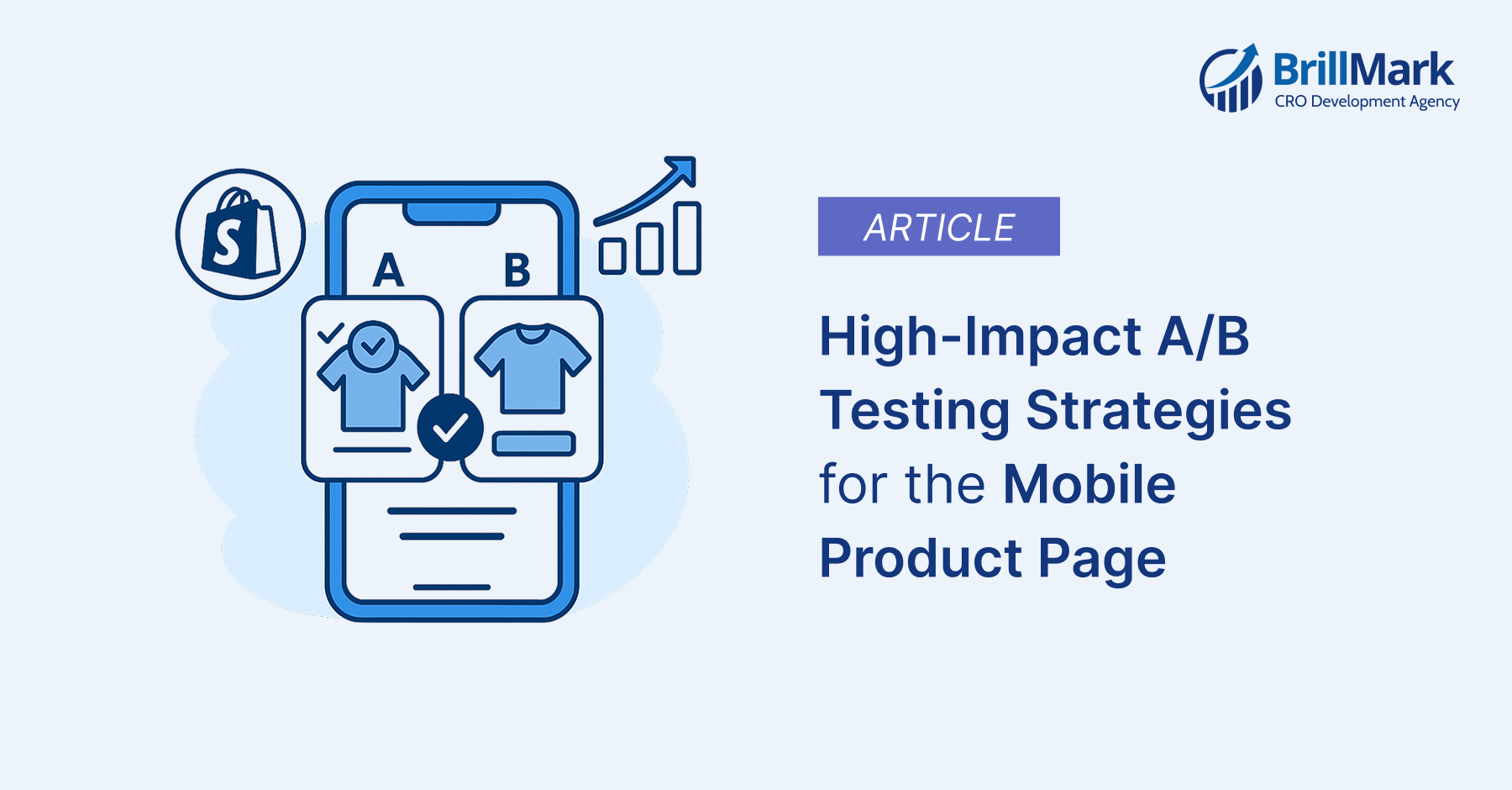Being an expert in eCommerce A/B Testing, let me be honest with you. Most mobile product pages are cluttered and disorganized. They’re slow. They’re clunky. And they’re losing you money every single day. But here’s the good news. Fixing them isn’t rocket science.
Why Your Mobile Traffic Isn’t Converting
Picture this. Someone searches “buy running shoes online” on their phone. They land on your page. And then… nothing happens.
They bounce. Your ad spend goes down the drain. You need to focus on eCommerce A/B Testing.
This happens because of three big problems:
- The wrong people are visiting. You’re not targeting the right search intent.
- Your page is frustrating to use. Slow load times and broken buttons kill conversions.
- You’re not testing what works. You’re guessing instead of measuring.
Let’s fix all three issues. Starting right now.
1. Getting The Right Traffic for eCommerce A/B Testing (The Smart Way)
Not all keywords are created equal. Some bring window shoppers. Others bring buyers.
A. Transactional Intent Keywords
These are your money makers. People using these phrases want to buy now. Think “buy wireless headphones” or “order pizza near me.”
When someone searches like this, they’re ready. Please don’t make them wait.
Your checkout needs to be lightning fast. No complicated forms. No surprises.
B. Commercial Investigation Keywords
These searchers are close to buying. They’re just doing final research.
Keywords like “best laptop under $1000” or “iPhone 15 vs Samsung S24.”
They’re comparing options. Reading reviews. Checking specs.
Give them what they need. Clear comparisons. Real customer reviews. Detailed specifications.
C. Long-Tail Keywords Drive Quality Traffic
Here’s something most people miss. Long-tail keywords are gold for mobile.
Instead of “shoes,” target “waterproof hiking boots for women size 8.”
These searches have less competition. And way better conversion rates.
The person searching knows exactly what they want. Your job is simple.
Show them you have it. Make buying easy.
2. The Hidden Killers of Mobile Conversion
Your analytics show traffic. But sales aren’t matching up.
Something’s breaking the experience. Let’s find out what.
A. Rage Clicks Tell You Everything
Ever tap a button repeatedly because it won’t work? That’s a rage click.
Tools like Microsoft Clarity and Hotjar track these. They show you exactly where users get frustrated.
Maybe your “Add to Cart” button isn’t responding fast enough. Maybe a link looks clickable but does nothing.
Fix these issues first. They’re conversion killers.
B. Dead Clicks Are Even Worse
A dead click happens when someone taps something that looks interactive. But isn’t.
Your product image might look like it zooms. It doesn’t. User frustration builds.
These seem small. But they add up. Each one chips away at trust.
C. Speed Matters More Than You Think
If your page takes more than three seconds to load? Half your visitors are gone.
Google’s Core Web Vitals track this. Largest Contentful Paint (LCP) should be under 2.5 seconds.
Optimize your images. Use lazy loading. Enable caching.
Speed isn’t just about user experience anymore. It affects your search rankings too.
Mobile-first indexing means Google judges your site by mobile performance.
Slow mobile page? Lower rankings. Fewer visitors. Less money.
D. Checkout Fatigue Is Real
Multi-step checkout on mobile feels like running a marathon. With hurdles.
People abandon carts because it’s too much work. Too many form fields.
The goal for 2025? One-click ordering wherever possible.
Save payment info. Pre-fill addresses. Remove unnecessary steps.
Every extra tap is a chance to lose the sale.
3. The A/B Tests That Actually Move The Needle
You can’t improve what you don’t measure. But you also can’t a/b test everything on mobile.
Focus on these high-impact areas first.
1. Sticky Add to Cart Buttons
This one change can boost your add-to-cart rate by 20% or more.
A sticky button stays visible as users scroll. They don’t have to scroll back up to buy.
Simple fix. Massive results.
Test it yourself. Use platforms like Optimizely or Shoplift.
You’ll likely see results within days.
2. CTA Copy Needs Work
“Buy Now” is boring. And sometimes it feels pushy.
Test benefit-driven copy instead. “Try Free for 30 Days” or “Start Your Journey.”
Even small changes matter. “Add to Cart” versus “Add to Bag.”
One might perform 15% better. You won’t know until you test.
3. Trust Signals Reduce Purchase Anxiety
Mobile shoppers are nervous. Small screen. Typing credit card numbers. They need reassurance.
Add customer reviews right above the fold. Show star ratings prominently.
Mention your warranty. Highlight secure checkout badges. Display “Free Returns” clearly.
In one case study, adding “Free Returns” near the CTA increased conversions by 25%.
That’s not a typo. Twenty-five percent from one small change.
4. Create Urgency Without Being Sleazy
Countdown timers work. But only if they’re real.
“Sale ends in 2 hours” can boost conversions. Just don’t fake it.
Stock scarcity messages work too. “Only 3 left in stock” creates FOMO.
But again, be honest. Fake urgency destroys trust forever.
5. Visual Content That Converts
Product images matter more on mobile. The screen is smaller. Details are harder to see.
Test lifestyle shots against plain white backgrounds. Try 360-degree views.
Video content can increase conversions by 80%. That’s huge.
But keep videos short. 30 seconds max. Show the product in use.
Auto-play on mute. Let users tap for sound. Don’t force it.
6. Price Presentation Testing
How you show price affects sales. Test different approaches.
Original price crossed out with discount. Just the sale price. Payment plans.
“$29.99” versus “$30.” Small differences. Big impact on perception.
One electronics retailer increased profits 12% just by changing price display.
4. Fixing Mobile Friction Points
Let’s talk about the annoying stuff that makes users leave.
1. Collapsible Sections Save Space
Mobile screens are small. Long product descriptions overwhelm users.
Use collapsible sections for specifications. Features. Shipping info.
Let users expand what they care about. Hide what they don’t.
This keeps pages clean. Reduces scroll fatigue. Improves engagement.
Download our Guide: 10 Ways to Eliminate Developer Bottlenecks in CRO & Experimentation Campaigns
5. Keywords That Actually Matter in 2025
SEO for product pages has evolved. Here’s what works now.
1. Optimize These Four Places
Your primary keyword needs to appear in specific locations:
- Product title. This is the most important spot. Use your exact target keyword.
- Headlines. Break up content with keyword-rich subheadings.
- Product description. Naturally weave keywords throughout. Don’t stuff them awkwardly.
- Image ALT text. Describe images using relevant keywords. Helps SEO and accessibility.
Aim for 5-7% keyword density. More feels spammy. Less misses opportunities for eCommerce A/B Testing.
2. Don’t Forget Informational Content
Not everyone landing on your PDP is ready to buy immediately.
Some are researching. Learning. Comparing options.
Include helpful content. “How to choose running shoes” or “What thread count means.”
This builds trust. Positions you as an expert. Improves time on page.
And it brings in informational intent traffic. Who eventually become buyers.
6. The Tools You Actually Need for eCommerce A/B Testing
Don’t buy expensive software you won’t use. Start with these essentials.
- Microsoft Clarity is free. Shows rage clicks, dead clicks, and session recordings.
- Google PageSpeed Insights measures Core Web Vitals. Also free.
- Hotjar for heat maps and user recordings. Paid but worth it.
For A/B testing, Google Optimize is free for basic tests. Optimizely for advanced stuff.
Start simple. Master one tool before adding more.
Also read 10 A/B Tests for eCommerce Product Display Pages | High Velocity Experimentation
Common A/B Testing Mistakes That Cost You Sales
I see these errors constantly. They’re easy to fix.
- Too many choices overwhelm users. Limit variants shown initially. Add “See more options” if needed for eCommerce A/B Testing.
- Hidden shipping costs. Show total price early. Surprises at checkout kill conversions.
- Tiny tap targets. Mobile buttons need to be at least 44×44 pixels. Smaller causes accidental clicks.
- Auto-playing videos with sound. Instant bounce. Don’t do this.
- Pop-ups that won’t close on mobile. Test your modals on actual phones.
What To A/B Test First on Mobile
You can’t optimize everything at once. Prioritize like this:
- Page load speed – Affects everything else
- Sticky CTA button – Quick win with big impact
- Trust signals above the fold – Reviews and ratings visible immediately
- CTA copy variations – Easy to test, often surprising results
- Product image styles – Lifestyle versus studio shots
Run eCommerce A/B tests for at least two weeks. Longer for low-traffic pages.
Don’t stop a winning test too early. Let it run.
The Bottom Line
Mobile e-commerce isn’t the future anymore. It’s right now.
Most of your traffic comes from phones. If your PDPs aren’t optimized? You’re bleeding money.
The fixes aren’t complicated. Fast loading. Clear CTAs. Trust signals. Easy checkout. Do it with A/B Test Development.
Test methodically. Measure everything. Double down on what works. So, your competitors are already doing this. You need to catch up. Fast.
Start with page speed today. Add a sticky CTA tomorrow. Build from there.
The conversion rates are waiting. You just need to unlock them. Contact us to Know More.











